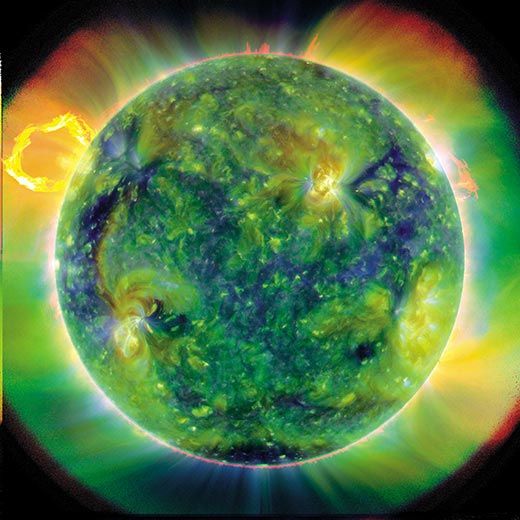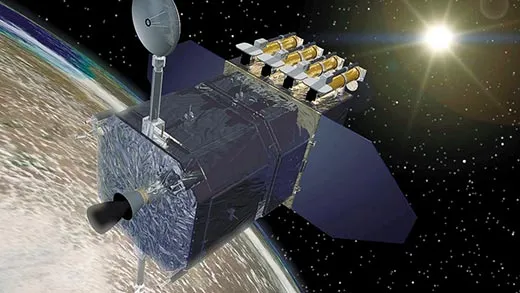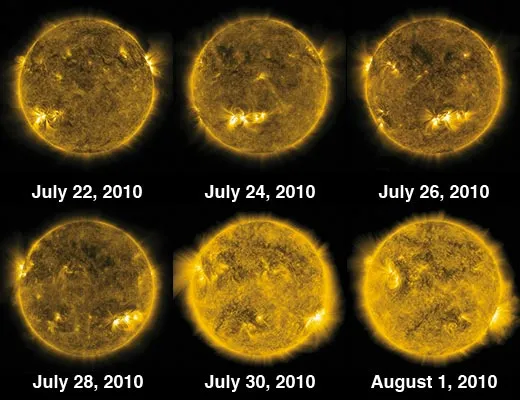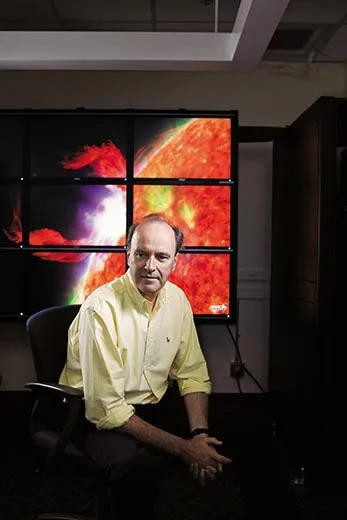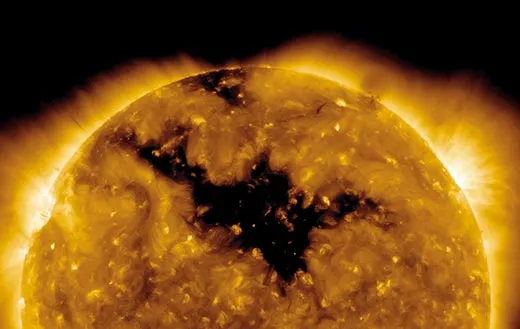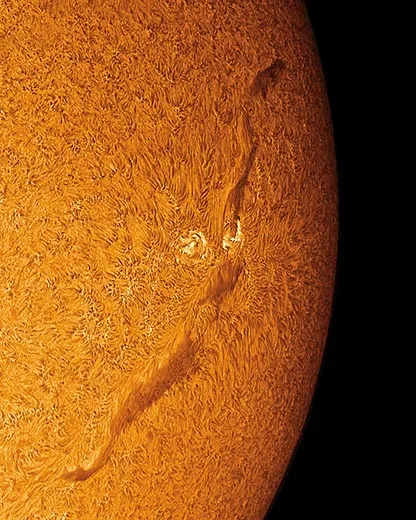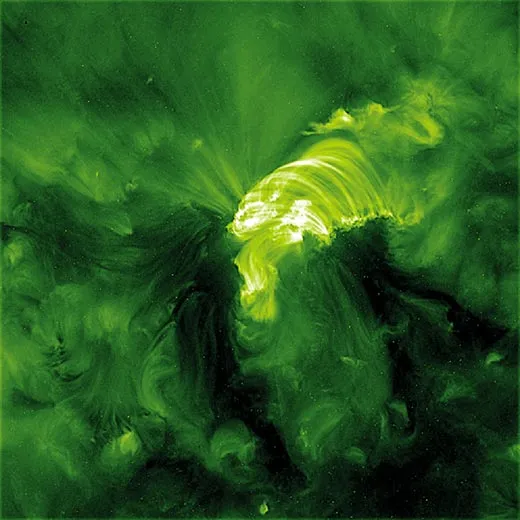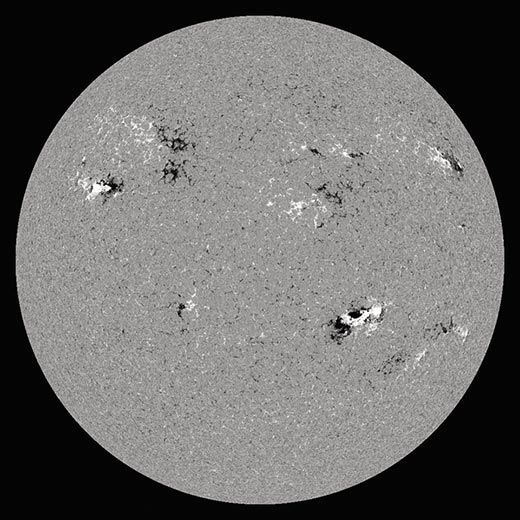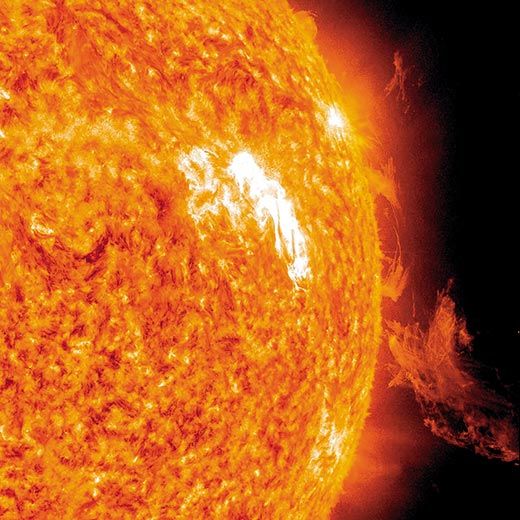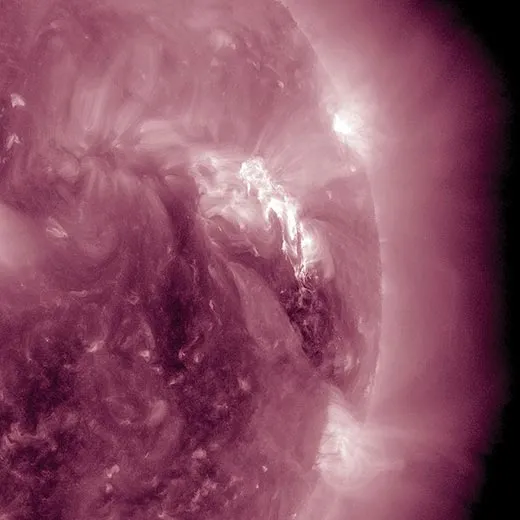Something New Under the Sun
Scientists are probing deep beneath the surface of our nearest star to calculate its profound effect on Earth
/https://tf-cmsv2-smithsonianmag-media.s3.amazonaws.com/filer/Sun-northern-lights-631.jpg)
On an uncharacteristically tropical morning in the San Francisco Bay Area, the ground shimmers with waves of heat, and it’s impossible to look to the sky without squinting. But the real heat is inside the Lockheed Martin Solar and Astrophysics Laboratory in Palo Alto. There, in a dark room stacked with computer processors, a high-definition view of the Sun fills nine conjoined TV screens to create a seven-foot-wide, theater-quality solar extravaganza.
Solar physicist Karel Schrijver types commands to start the show: an accelerated movie of a sequence of explosions that wracked the Sun on August 1, 2010. “This is one of the most stunning days I’ve ever seen on the Sun,” Schrijver says. He’s been looking at our nearest star for two decades.
“At the beginning this tiny little region decides it’s not happy,” he says, sounding like an astronomical psychiatrist coping with solar neuroses. He points to a flare, a modest spasm of whitish light. “Then, this nearby region begins to get unhappy, and it flares. Then a huge filament erupts and cuts through the [magnetic] field like a knife. We see this arc of glowing material, and it grows with time. A little filament under the arc says, ‘I don’t like that one bit,’ and it becomes unstable and goes off.”
Who knew the Sun has so much personality?
Within hours—sped up to minutes in the digitized replay—much of its magnetic field “gets upset,” Schrijver says, and rearranges itself, unleashing flares and vast belches of magnetized gas. The chain reaction is more vivid than any Hollywood depiction. “When we show these movies to our colleagues for the first time,” says Schrijver, “the professional expression is generally, ‘Whoa!’”
The torrent of images comes from the most advanced satellite ever to study the Sun: NASA’s Solar Dynamics Observatory, or SDO. Launched in February 2010, SDO stares at the star from a point 22,300 miles above Earth. The satellite’s orbit keeps it at a steady position in view of two radio antennas in New Mexico. Every second, 24 hours a day, SDO beams 18 megabytes of data to the ground. The high-resolution pictures, as well as maps of the Sun’s tortured magnetic fields, show the genesis of sunspots and the origins of their outbursts.
This solar movie should provide new insights into space weather—the impacts felt on Earth when the Sun’s ejections head our way. Sometimes the weather is mild. The August 1, 2010, eruptions set off colorful displays of aurora borealis over the United States two days later when a fast-moving storm of charged gas disturbed Earth’s magnetic field. But when the Sun truly gets angry, the northern lights can signal potentially disabling threats.
The most intense solar storm ever recorded struck in the summer of 1859. British astronomer Richard Carrington observed a giant network of sunspots on September 1, followed by the most intense flare ever reported. Within 18 hours, Earth was under magnetic siege. Dazzling northern lights glowed as far south as the Caribbean Sea and Mexico, and sparking wires shut down telegraph networks—the Internet of the day—across Europe and North America.
A magnetic storm in 1921 knocked out the signaling system for New York City’s rail lines. A solar storm in March 1989 crippled the power grid in Quebec, depriving millions of customers of electricity for nine hours. And in 2003, a series of storms caused blackouts in Sweden, destroyed a $640 million Japanese science satellite and forced airlines to divert flights away from the North Pole at a cost of $10,000 to $100,000 each.
Our modern, globally connected electronic society is now so reliant on far-flung transformers and swarms of satellites that a major blast from the Sun could bring much of it down. According to a 2008 report from the National Research Council, a solar storm the size of the 1859 or 1921 events could zap satellites, disable communication networks and GPS systems and fry power grids at a cost of $1 trillion or more.
“The space around us isn’t as benign, friendly and accommodating to our technology as we had assumed,” Schrijver says.
By documenting the origins of these storms in unprecedented detail, SDO gives researchers their best chance yet to understand the Sun’s destructive capabilities. The goal is to forecast space weather—to read the Sun’s moods far enough in advance that we can take precautions against them. Success will rely upon gazing through the Sun’s surface to see magnetic outbursts as they develop, in much the same way that meteorologists use cloud-penetrating radar to see signs of a tornado before it roars to the ground.
But for now, the Sun’s activity is so complex that its convulsions baffle the field’s top minds. When asked to explain the physics that drives the Sun’s violence, SDO scientist Philip Scherrer of Stanford University minces no words: “We fundamentally don’t know.”
Our parent star is just eight minutes away, as the light flies. The Sun gets more telescope time than any other object in space, and the research is a global enterprise. The most successful satellite prior to SDO, a joint NASA-European Space Agency mission called the Solar and Heliospheric Observatory (SOHO), still sends back images of the Sun 15 years after its launch. A smaller explorer now in space, called Hinode, is a Japan-NASA collaboration that studies how the Sun’s magnetic fields store and release energy. And NASA’s Solar Terrestrial Relations Observatory (STEREO) mission consists of two nearly identical satellites traveling in Earth’s orbit, one in front of our planet and one behind. The satellites allow scientists to create 3-D images of solar ejections. Now on opposite sides of the Sun, this past February they took the first photo of the Sun’s entire surface. On the ground, telescopes in the Canary Islands, California and elsewhere examine the Sun with techniques that eliminate the blurring effects of Earth’s atmosphere.
The Sun is a spinning ball of gas large enough to contain 1.3 million Earths. Its core is a furnace of nuclear fusion, converting 655 million tons of hydrogen into helium every second at a temperature of 28 million degrees Fahrenheit. This fusion creates energy that ultimately reaches us as sunlight. But the core and inner layers of the Sun are so dense that it may take a million years for a photon of the energy to fight just two-thirds of the way out. There it reaches what solar physicists call the “convective zone.” Above that is a thin layer we perceive as the Sun’s surface. Solar gases continue far into space beyond this visible edge in a blazing hot atmosphere called the corona. A tenuous solar wind blows through the entire solar system.
Things get especially interesting in the convective zone. Giant gyres of charged gas rise and fall, as in a pot of boiling water, only more turbulent. The Sun rotates at different speeds—about once every 24 days at its equator and more slowly, about every 30 days, at its poles. This difference in velocity shears the gas and tangles its electrical currents, fueling the Sun’s magnetic fields. The overall magnetic field has a direction, just as Earth’s north and south poles attract our compasses. However, the Sun’s field is full of curves and kinks, and every 11 years, it flips: the north pole becomes the south, then back to north again 11 years later. It’s a dynamic cycle that scientists don’t fully grasp, and it’s at the heart of most efforts to understand how the Sun behaves.
During those flips, the Sun’s deep magnetic field gets really gnarled. It rises up and pokes through the visible surface to create sunspots. These dark patches of gas are cooler than the rest of the Sun’s surface because the knotted magnetic fields act as barriers, preventing some of the Sun’s energy from escaping into space. The fields in sunspots have the potential to erupt. Above sunspots, the Sun’s magnetic field loops and swirls through the corona. These writhings ignite the explosions on Lockheed’s video screens in Palo Alto.
Schrijver and his boss, Alan Title, have worked together for 16 years, long enough to complete each other’s sentences. Their group’s latest creation, the Atmospheric Imaging Assembly—a set of four telescopes that take pictures of million-degree gases in the corona—is one of three instruments deployed on SDO. NASA compares it to an IMAX camera for the Sun.
“This bubble of gas blowing off is 30 times Earth’s diameter, moving at a million miles an hour,” Title says, pointing on the screen to an expanding red vortex caught by SDO soon after the satellite’s launch. And, he notes almost casually, this was a fairly minor eruption.
Magnetic fields keep the Sun’s gases in line as they arch into space, Title says, much as a bar magnet puts iron filings into neat patterns. The more tangled the fields become, the less stable they are. Solar outbursts happen when the magnetic fields snap into a new pattern—an event that physicists call “reconnection.”
A typical solar outburst expelled toward Earth, called a coronal mass ejection, might contain ten billion tons of charged gas racing across space. “You have to imagine a set of forces sufficient to launch all of the water in the Mississippi River to a velocity 3,000 times faster than a jet plane flies, in 15 to 30 seconds,” he says, pausing a moment to let that sink in. “There is no counterpart to this on Earth. We have trouble explaining these processes.”
Previous solar missions took fuzzy snapshots of large coronal mass ejections. Other telescopes zoomed in for fine details but could focus on only a tiny portion of the Sun. SDO’s high resolution of an entire hemisphere of the Sun and its rapid-fire recordings reveal how the surface and atmosphere change minute to minute. Some features are so unexpected that the scientists haven’t yet named them, such as a corkscrew-like pattern of gas that Schrij-ver traces on the screen with his finger. He thinks it’s a spiraling magnetic field seen along its edge, lacing through gas as it ascends into space. “It’s like [the gas] is being lifted in slings,” he says.
Before the mission was a year old, the scientists had analyzed hundreds of events, covering many thousands of hours. (The August 1 eruptions, they found, were linked by magnetic “fault zones” spanning hundreds of thousands of miles.) The team is working under pressure, from NASA and elsewhere, for better forecasts of space weather.
“Good Lord, this is complicated,” says Schrijver, playing a movie of the Sun’s mood on another day. “There is no quiet day on the Sun.”
A few miles away, on the campus of Stanford, solar physicist Philip Scherrer is wrestling with the same question that animates the Lockheed Martin group: Will we be able to predict when the Sun will cataclysmically hurl charged gas toward Earth? “We’d like to give a good estimate whether a given active region will produce flares or mass ejections, or if it will just go away,” he says.
Scherrer, who uses a satellite downlink for television reception, explains the impact of space weather by recalling an event in 1997. “One Saturday, we woke up and all we saw was fuzz,” he says. A coronal mass ejection had swept past Earth the night before. The magnetic cloud apparently took out the Telstar 401 satellite used by UPN and other networks.
“I took that personally, because it was ‘Star Trek’ [I was unable to watch],” Scherrer says with a wry smile. “If it had happened on the morning of the Super Bowl, everyone would have known about it.”
Scherrer’s team and Lockheed Martin engineers developed SDO’s Helioseismic and Magnetic Imager, an instrument that probes into the Sun’s churning interior and monitors the direction and strength of the magnetic field, creating black-and-white maps called magnetograms. When sunspots come along, the maps show magnetic turmoil at the bases of arching structures in the Sun’s atmosphere.
The instrument also measures vibrations on the Sun’s surface. On Earth, seismologists measure surface vibrations to reveal earthquake faults and geologic structures far underground. On the Sun, vibrations come not from sunquakes but from pulsations caused by gases heaving up and down on the surface at speeds of some 700 miles per hour. As each blob of gas crashes down, it propels sound waves into the Sun, and they jiggle the entire star. Scherrer’s device gauges those vibrations across the Sun’s face.
The key, says Scherrer, a leading expert in helioseismology, as this science is known, is that the sound waves move faster through hotter gas, such as turbulent knots far below the surface that often presage sunspots. The sound waves also accelerate when they move through gases flowing in the same direction. Although these measurements create mathematical nightmares, computers can create pictures of what’s happening under the Sun’s surface.
In this way, Scherrer’s team can detect sunspots on the far side of the Sun days before they rotate into view and before they are in position to spew harmful particles and gas toward Earth. The scientists also hope to spot active regions bubbling up from within the Sun a day or more before they are visible as sunspots.
These techniques provide previews of coming attractions. The challenge, Scherrer says, is finding the right signs of magnetic entanglement that—like the radar images of a newly forming tornado—give reliable warnings. Some researchers have keyed in on the shapes of magnetic fields, noting that a particular S-shaped curvature often heralds an outburst. Others look at whether magnetic strength across the center of a sunspot changes quickly—an indication that it might be ready to snap.
Scherrer calls up some pictures on his screen, apologizing that they don’t rival the Lockheed movies. The helioseismic images remind me of the knobby surface of an orange, with nodules of gas surging upward across the Sun’s entire sphere. The magnetic graphics cast the Sun in mottled gray tones, but when Scherrer zooms in, black and white flecks grow into irregular patches. These are the ribbons of magnetic force, poking into or out of the Sun’s constantly moving surface.
When magnetic field lines reconnect high in the Sun’s atmosphere, Scherrer says, “it’s very much like a short circuit when you touch two wires with a current. The energy flowing in the current turns into heat or light.” The sudden sparks shoot down along the magnetic field and slam into the Sun’s surface, setting off a powerful flare.
The strongest of the Sun’s arching magnetic fields can trap billions of tons of gas beneath them, setting the stage for coronal mass ejections. When a magnetic reconnection suddenly releases all that tension, the gas lifts off into space with the solar wind. “It’s like cutting the string on a helium balloon,” Scherrer says.
By studying many such events, Scherrer thinks he and his colleagues can devise a system that ranks the odds of the Sun aiming an eruption at Earth—a scale that might run from “all clear” to “take precautions.” Such guidelines would not be predictions, he admits, and he acknowledges, too, that solar forecasting may never rival earthly weather reports. Solar predicting requires the team to compare recent activity on the Sun with computer models. But the models are so involved that by the time the computer spits out an answer, the Sun may already have popped off or stayed quiet.
One of the biggest solar surprises in the past 50 years wasn’t something the Sun did but something it didn’t do: it didn’t produce many sunspots for most of 2008 and 2009. “We’d go 60, 70, 80, 90 days without a single sunspot,” says NASA science editor Tony Phillips, who independently publishes SpaceWeather.com. “In the lifetime of solar physicists, no one had seen this. It surprised the entire community.”
No one knows what caused the eerie quiet. The deep magnetic field apparently did not twist up in its usual way, perhaps because electrical currents inside the Sun grew weaker. Some scientists speculated that the Sun was powering down, at least temporarily. A panel of solar physicists studied these changes and projected that the Sun’s activity might reach just half of its recent levels in its next 11-year sunspot cycle. This could have minor implications for climate change. For the past century, human activity far outweighed the Sun’s modulations in affecting Earth’s climate. If the pattern of reduced solar activity continues through another of the Sun’s cycles and beyond, the subtle decrease in energy from the Sun could slightly offset global warming.
The Sun is projected to reach the peak of its current sunspot cycle in late 2013 or early 2014. But there’s no reason to think a more sedate Sun will stay that way. “The biggest particle event and geomagnetic storm in recorded history”—the 1859 event observed by Carrington—“occurred during a solar cycle of about the same size as the one we’re projecting in the next couple of years,” says Phillips. Moreover, a recent study by Suli Ma and colleagues at the Harvard-Smithsonian Center for Astrophysics showed that one-third of the solar storms striking Earth arise without solar flares or other warning signs. These sneak attacks suggest that the Sun can be hazardous even when it appears quiet.
There’s no way to shield the Earth from the Sun’s eruptions; powerful storms will always disrupt our planet’s magnetic field. But advance warning can limit their impact. Precautions include reducing power loads to prevent surges on electrical lines, putting satellites into an electronic safe mode, and—in NASA’s case—telling astronauts to take shelter within the most fortified parts of their spacecraft.
Even with those measures, an event as severe as the solar storms of 1859 or 1921 would wreak havoc, says solar and space physicist Daniel Baker of the University of Colorado, lead author of the 2008 National Research Council report. People grow more dependent on communications technology by the year, Baker says, making us ever more vulnerable to electromagnetic chaos. “Those [severe] events probably occur every decade,” he says. “It’s just a question of time before one of them hits us.”
Baker and his colleagues have urged NASA and the National Oceanic and Atmospheric Administration, which runs the Space Weather Prediction Center in Boulder, Colorado, to develop a system of space-weather warning satellites. Today the only instrument that can determine the direction of the magnetic field inside an approaching coronal mass ejection—a critical factor for determining how violently it will interact with Earth—is on a 13-year-old satellite that has no near-term replacement.
“The Sun is a highly variable star,” Baker warns. “We live in its outer atmosphere, and the cyber-electric cocoon that surrounds Earth is subject to its whims. We’d better come to terms with that.”
Robert Irion directs the science writing program at the University of California at Santa Cruz.
